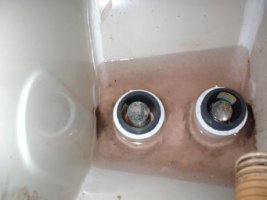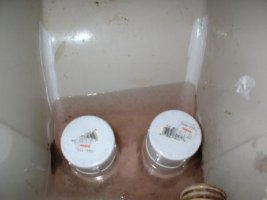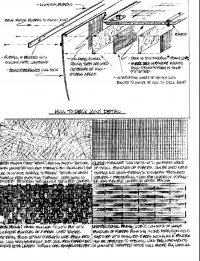You are using an out of date browser. It may not display this or other websites correctly.
You should upgrade or use an alternative browser.
You should upgrade or use an alternative browser.
keel/hull joint;
I had the same condition on my 1990 30+, only mine was leaking. What I did was brace the keel in position, loosened all the keel bolts, lifted the hull aprox. 3/4 in and cleaned the hull & keel faces. Then I applied aproxamately 6 tubes of 3M 5200 to the faces, lowered the hull & retightened the bolts.
If your joint isn't leaking yet, I would first a) tighten all the keel bolts (150-225 ft.lbs.of torque), b) clean the crack out as best I could with scrapers & sand paper, c) power wash the crack & dry throughly, & d) fill w/5200. I did this on my E34 that I presently own and it is working fine.
Glassing over the joint won't help as there tends to be a little movement at this point (OK) and anything that isn't flexible will just crack & fall off. As long as the surfaces are clean & dry, 5200 will bond to them and give you the flexible sealing surface you need. Basically it functions like a gasket.
The movement comes when you heel over and 4000 lbs. of lead is attached at a point 6" wide and tilted at 20 degree angle. The engineers on this web site will probably be able to figure the exact numbers, but the point loads are incredible and to try to make it rigid enough to not flex is almost impossible. Better to let it move and give it something flexible.
All keel bolts have a tendency to loosen over time. The best way to check tightness is with the boat hauled and the hull weight resting on the keel. This way you're not trying to tighten the bolt AND lift the 4000 lbs. of lead at the same time. Give yourself a break, man. It's tough enough as it is. Basically, as tight as you can make them (unless you can bench press 400 lbs.) is tight enough. Twisting off a 3/4 dia. bolt by hand is almost impossible for normal humans unless you're using a 6 ft. piece of pipe on the end of the wrench.
Hope this helps you out. The first fix I laid out is a worst case senario only. Mine was leaking faster than 800 gal/hr so a drastic fix was needed. I recommend the second way for most conditions.
Good luck & sail fast
Bud E34 "Escapade"
I had the same condition on my 1990 30+, only mine was leaking. What I did was brace the keel in position, loosened all the keel bolts, lifted the hull aprox. 3/4 in and cleaned the hull & keel faces. Then I applied aproxamately 6 tubes of 3M 5200 to the faces, lowered the hull & retightened the bolts.
If your joint isn't leaking yet, I would first a) tighten all the keel bolts (150-225 ft.lbs.of torque), b) clean the crack out as best I could with scrapers & sand paper, c) power wash the crack & dry throughly, & d) fill w/5200. I did this on my E34 that I presently own and it is working fine.
Glassing over the joint won't help as there tends to be a little movement at this point (OK) and anything that isn't flexible will just crack & fall off. As long as the surfaces are clean & dry, 5200 will bond to them and give you the flexible sealing surface you need. Basically it functions like a gasket.
The movement comes when you heel over and 4000 lbs. of lead is attached at a point 6" wide and tilted at 20 degree angle. The engineers on this web site will probably be able to figure the exact numbers, but the point loads are incredible and to try to make it rigid enough to not flex is almost impossible. Better to let it move and give it something flexible.
All keel bolts have a tendency to loosen over time. The best way to check tightness is with the boat hauled and the hull weight resting on the keel. This way you're not trying to tighten the bolt AND lift the 4000 lbs. of lead at the same time. Give yourself a break, man. It's tough enough as it is. Basically, as tight as you can make them (unless you can bench press 400 lbs.) is tight enough. Twisting off a 3/4 dia. bolt by hand is almost impossible for normal humans unless you're using a 6 ft. piece of pipe on the end of the wrench.
Hope this helps you out. The first fix I laid out is a worst case senario only. Mine was leaking faster than 800 gal/hr so a drastic fix was needed. I recommend the second way for most conditions.
Good luck & sail fast
Bud E34 "Escapade"
Keel info
See my message in the Maint. forum, 2-10-2002. And do a search on the Keel bolt or keel. Wonderful search engine on this server...
Small "search" icon, upper right part of your screen.
At 13 years, it would seem a couple years too early to rebed your keel, but OTOH it might easier to just "do it right the first time" and probably cheaper than kludged "fixes" that have to be re-kludged later...
Just my .02 worth,
Loren in PDX
See my message in the Maint. forum, 2-10-2002. And do a search on the Keel bolt or keel. Wonderful search engine on this server...
Small "search" icon, upper right part of your screen.
At 13 years, it would seem a couple years too early to rebed your keel, but OTOH it might easier to just "do it right the first time" and probably cheaper than kludged "fixes" that have to be re-kludged later...
Just my .02 worth,
Loren in PDX
Geoff Johnson
Fellow Ericson Owner
When I had my keel rebedded about six years ago, the yard was going to use 5200. However, I called Pacific Seacraft and was instructed to use epoxy instead and to make sure the epoxy was applied within 10 minutes of cleaning the the keel surface (lead apparently will corrode, degrading the bond). The crack has not opened since I had this done. So you might want to give PSC a call. They were very helpful (even though they did not make my boat). However, 5200 was squeezed around the keel bolts to keep the bilge water out.
PS, I have since encapsulated the bolts with PVC pipe to keep them dry. The pipe was attached to the washers (which I first cleaned) using 4200. See attached photo showing PVC pipe without screw caps.
PS, I have since encapsulated the bolts with PVC pipe to keep them dry. The pipe was attached to the washers (which I first cleaned) using 4200. See attached photo showing PVC pipe without screw caps.
Attachments
Last edited:
Geoff Johnson
Fellow Ericson Owner
Keel joint
Geoff and Bud are both right on. The traditional method is to use the sealant, and this SHOULD be the right solution. It also allows you to drop the keel more easily in the future if need be.
Both are proper methods and should give a good, dry seal.
Good sailing!
S
Geoff and Bud are both right on. The traditional method is to use the sealant, and this SHOULD be the right solution. It also allows you to drop the keel more easily in the future if need be.
Both are proper methods and should give a good, dry seal.
Good sailing!
S
Geoff Johnson
Fellow Ericson Owner
Seth, since you worked at Ericson, I would be interested to know how the company fiberglassed the deck to the hull from the inside (as shown in the attached page from my manual). It seems like a very difficult and time consuming method, which is probably why I have not seen it used on any other boat.
Attachments
hull-deck joint
If I recall, both the hull and deck had outward facing flanges. The deck was set on the hull, and the flanges were screwed down to each other on the OUTSIDE of the hull. They were then bonded together on the inside. When that had cured, the flange, screws, etc. were all cut off, leaving a small lip. If you looked straight at the lip you from the side you would se the top and bottom pieces bonded together. The plastic extrusion for the rubrail was then fit over the lip (sealed with 5200) and screwed into the joint, and the rubber portion of the rubrail slid into the extrusion.
A little odd, but each builder had its' quirks. If you need to chat you can email me privately or call.
Regards,
S
If I recall, both the hull and deck had outward facing flanges. The deck was set on the hull, and the flanges were screwed down to each other on the OUTSIDE of the hull. They were then bonded together on the inside. When that had cured, the flange, screws, etc. were all cut off, leaving a small lip. If you looked straight at the lip you from the side you would se the top and bottom pieces bonded together. The plastic extrusion for the rubrail was then fit over the lip (sealed with 5200) and screwed into the joint, and the rubber portion of the rubrail slid into the extrusion.
A little odd, but each builder had its' quirks. If you need to chat you can email me privately or call.
Regards,
S
Seth is correct in his description. I would not characterize
this joint as labor intensive but rather expedient for
a production boat.
More preferable would be the joint used on
the 30mk1, 31C, 36C, 37, 41, and 46. The hull flange
turns inward, the deck is bedded to that, and the toe rail
(either aluminum or teak) is then thru-bolted. This is how
it is done on Swans, Hinckleys and other high end boats.
Martin
this joint as labor intensive but rather expedient for
a production boat.
More preferable would be the joint used on
the 30mk1, 31C, 36C, 37, 41, and 46. The hull flange
turns inward, the deck is bedded to that, and the toe rail
(either aluminum or teak) is then thru-bolted. This is how
it is done on Swans, Hinckleys and other high end boats.
Martin
Last edited:
Geoff Johnson
Fellow Ericson Owner
I am not sure that's a fair criticism. I believe that Hallberg-Rassy's are made by laminating the deck to the hull (and H-R hulls are Lloyd's inspected during construction). Fiberglass lamination of the deck to the hull is also one of the selling points of the highly rated Amel. The method is certainly much better than the Beneteau method (a return flange which is glued and fastened by self-tapping screws), although Beneteau claims its joint has never failed. Also, Ericson's apparent use of Divinycell instead of balsa in the deck core seems a cut above the normal production boat.
Last edited:
Our Olson 34 uses an inward lip along the top of the hull, with the deck thru-bolted through a slotted aluminum rail on the top and washers and nuts underneath. That was one of the reasons we bought the boat. This was the way our prior boats were constrcted (Niagara 26 and Ranger 20). AFAIK this is one of the strongest hull-to-deck joints.

Loren in PDX
Olson 34 #8
Loren in PDX
Olson 34 #8
hull joint
Loren,
I also love those type of joints using the slotted toe rail. C&C did it for years. The big advantage is unlimited lead positions for the outboard leads when reaching!
FWIW, this has gone out of favor because of weight, and cost. You really don't need THAT many lead positions, and a few well placed padeyes will do as well at less cost and weight penalty.
I still like 'em, though!
S
Loren,
I also love those type of joints using the slotted toe rail. C&C did it for years. The big advantage is unlimited lead positions for the outboard leads when reaching!
FWIW, this has gone out of favor because of weight, and cost. You really don't need THAT many lead positions, and a few well placed padeyes will do as well at less cost and weight penalty.
I still like 'em, though!
S
Speaking of aluminum "slotted" toe rails... the absolute best of the bunch was the aluminum T-Track rail on our Niagara 26. Hinterhoeller did this on most of his Niagaras and Nonesuch boats. I had several sliding eye's that I could move all along the rail for spinnaker leads or attaching fenders, or tieing off a spring line, or...... ??
It was wonderful!
And, unlike those teak toe rails on the Tartans, no varnishing!

Happy Thanksgiving,
Loren in PDX
It was wonderful!
And, unlike those teak toe rails on the Tartans, no varnishing!
Happy Thanksgiving,
Loren in PDX
Geoff Johnson
Fellow Ericson Owner
Loren, I'm not familiar with the Olsons, but my 32-3 has a T-track outboard of the genoa track on the rail. It is very handy for spinnaker blocks and movable cleats. One disadvantage of the aluminum toe rail is that on some boats it is carried so far forward that it chafes lines running to the cleats. One of the really great design features of the Ericson is that the cleats are installed so that the line will not chafe. Many boats have been lost in my mooring field due to chocks.
Last edited:
Sven
Seglare
Hi Martin,
Do you happen to remember how the E23 MK-II hull to deck joint was constructed, or can you point me to a page that diagrams it ? I'm assuming it is not included in the plan details which were about to order via Pam at B.K.Y.D. ?
Thanks,
-Sven
Originally posted by Martin King
Seth is correct in his description. I would not characterize
this joint as labor intensive but rather expedient for
a production boat.
More preferable would be the joint used on
the 30mk1, 31C, 36C, 37, 41, and 46. The hull flange
turns inward, the deck is bedded to that, and the toe rail
(either aluminum or teak) is then thru-bolted. This is how
it is done on Swans, Hinckleys and other high end boats.
Martin
Do you happen to remember how the E23 MK-II hull to deck joint was constructed, or can you point me to a page that diagrams it ? I'm assuming it is not included in the plan details which were about to order via Pam at B.K.Y.D. ?
Thanks,
-Sven



